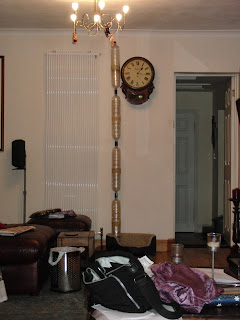 |
| A collection of bits and pieces ready to start work |
I decided its about time I got back into making some progress on my rockets, sorry for the long wait!
I decided I'd start by remaking the In-line Deployment System which got heavily damaged during the last launch day due to a previously described (cough) mess up on my behalf. I decided to use the same design as previous but adding a few small alterations and strengthening features.
The first and main feature I wanted to change was the way the top parachute bay Disk was held in, before I had relied entirely on the correx press fit to sit snugly in between one of the bottles formed ribs and a skewer poked through to hold it all in place.
This method had the main problem that it would pop out due to the forces on launch, the only thing holding it still being the bamboo skewer which started to rip through the outer casing after the first launch even before the crash. Therefore this time it I have used sikaflex to glue it all in place giving it much more strength.
 |
| Top Disk glued in place using Sikaflex |
Next up was the main internals, being the part that holds the timer and battery in place with room for a ballast capsule in the centre. Before this had been loosely taped to the lower mounting disk of the pod meaning it wobbled around a little in the casing, no biggie but I thought i may as well change it while the lot was being rebuilt, so it also was glued to the lower disk.
 |
| Sanded ready for gluing |
 |
| Sikaflex applied ready for positioning |
 |
| Assembly at the Half Way stage |
The Nose Cone, now not that it had any major issues in regards to how it worked I had come across a few bits and pieces I wanted to change. One thing I had noticed during a few flights is when the rocket was recovered the PET spring in the Nose Cone hadn't actually sprung back, it would get caught compressed to one side of the inner walls, so i made the change by using 2 rubber bands and 2 correx squares glued together at opposite orientations as the pressure plate. This change adds a little weight but the reliability gain i feel I'll have is invaluable especially now bigger parachutes are going to be a requirement.
The other small change to the Nose Cone is its size, its slightly larger then previous to accommodate larger parachutes.




 |
| The completed article |
I am going to try and get out and have a Launch day over the next week or two before the weather becomes totally insufferable.
I hope this update has been enjoyable and a good break of my Blog Silence as of late.
To the new followers of my Blog WELCOME! I hope you will find my progress interesting.
On another subject I will soon be starting another Blog Page based on another hobby of mine, I have started building a 2 inch to the foot scale traction engine of which I will be writing about should anyone be interested.
Regards Doug =]
 I have just finished making the fin set we are to use on this series, which in this case was the last piece of the puzzle and the rocket is now complete.
I have just finished making the fin set we are to use on this series, which in this case was the last piece of the puzzle and the rocket is now complete.


















